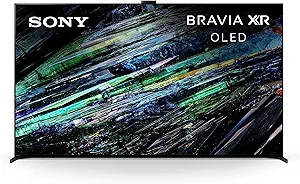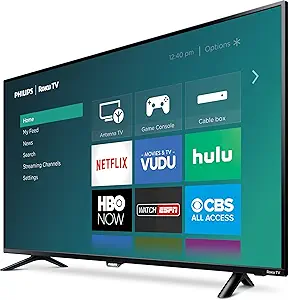The realm of home entertainment is a battleground for giants, and two prominent contenders vying for the spotlight are Sony and Philips. Both brands have etched their names into the annals of consumer electronics, each offering a unique blend of technology and innovation in their television lineup. In this article, we dissect the clash between Sony and Philips TVs, exploring the nuances that set them apart and the considerations for consumers in this competitive market.
Sony TVs: A Legacy of Innovation
Sony, a stalwart in the world of consumer electronics, has a long-standing reputation for pushing the boundaries of innovation. Sony TVs are synonymous with cutting-edge technology, premium build quality, and an unwavering commitment to delivering an unparalleled viewing experience.
Sony's incorporation of OLED and proprietary display technologies like TRILUMINOS™ sets its TVs apart, providing vibrant colors, deep blacks, and exceptional clarity. The X1 Ultimate processor, a hallmark of many Sony models, ensures advanced image processing, reducing noise and optimizing color for a visually stunning result. Sony's dedication to immersive audio is evident with features like Acoustic Surface Audio, turning the TV screen into a speaker for an unparalleled audio-visual experience.
However, Sony's commitment to excellence often comes with a premium price tag, placing its TVs in the higher echelons of the market.
Philips TVs: European Craftsmanship and Ambilight Brilliance
Philips, a European stalwart in the electronics industry, brings its own blend of craftsmanship and innovation to the television market. One of Philips' standout features is Ambilight technology, which projects ambient lighting onto the walls behind the TV, enhancing the viewing experience by extending colors beyond the screen.
Philips TVs often feature proprietary technologies such as P5 Perfect Picture Engine, enhancing image sharpness, color accuracy, and motion handling. The brand's commitment to immersive sound is exemplified by technologies like Dolby Atmos, providing a captivating audio experience.
While Philips TVs may not always match the premium build quality of Sony, they offer a compelling option for consumers seeking a European touch to their home entertainment setup.
Picture Quality
LG and Panasonic stand as prominent contenders in the television industry, each presenting a diverse array of models equipped with cutting-edge features. Concerning display quality, both brands exhibit notable strengths. LG distinguishes itself with its NanoCell technology, which enhances color accuracy and provides a broader spectrum, resulting in vivid and lifelike visuals. Additionally, LG's OLED displays offer unrivaled contrast ratios, delivering deep blacks and brilliant whites for an immersive viewing experience. Furthermore, LG's TruMotion technology effectively reduces motion blur, ensuring smooth and clear images, particularly during fast-paced scenes. Conversely, Panasonic boasts its HCX Pro Intelligent Processor, renowned for its precision in optimizing picture quality. This processor refines color accuracy and sharpness while maintaining superior contrast levels, resulting in stunningly realistic images. Panasonic's HDR support further enhances the dynamic range, reproducing lifelike details in both bright and dark scenes. However, some users have noted that Panasonic TVs may lack the same level of brightness as LG models, impacting the viewing experience in well-lit environments. Overall, both LG and Panasonic offer exceptional picture quality, but LG's advanced display technologies and motion handling capabilities may appeal to discerning viewers.
Design
LG and Samsung televisions are both esteemed for their innovative design concepts, each embodying distinctive approaches to visual aesthetics. LG televisions exhibit a sleek and modern design ethos, characterized by slim profiles and minimalistic bezels that seamlessly integrate into contemporary home environments. The latest models, like the LG OLED C1, feature a refined stand design that adds stability while maintaining elegance. LG's OLED Evo panels offer stunning picture quality with unparalleled contrast and vibrant colors, further enhancing the overall viewing experience. Additionally, LG's Gallery Design OLED TVs mimic the appearance of artwork when mounted flush against the wall, elevating the ambiance of any room. Conversely, Samsung televisions prioritize a blend of style and functionality, often boasting ultra-slim profiles and bezel-less designs for a futuristic aesthetic. The Samsung Frame TV series, for instance, doubles as a customizable digital art display when not in use, seamlessly integrating into home decor. Samsung's QLED technology delivers exceptional brightness and color accuracy, ensuring vivid and lifelike images across various viewing conditions. However, Samsung TVs may lack the same level of depth in black levels as LG's OLED displays. Despite this, Samsung compensates with advanced features like Quantum HDR and Object Tracking Sound, which further enrich the viewing experience. Overall, both LG and Samsung offer compelling design choices tailored to different preferences, with LG excelling in sleek modernity and Samsung embracing futuristic elegance.
Sound
Samsung and LG televisions are both celebrated for their remarkable sound performance, leveraging distinct technologies to elevate the auditory immersion. Samsung TVs integrate Adaptive Sound technology, dynamically adjusting audio parameters to suit the content being played, whether it's dialogue, music, or action scenes. Additionally, Samsung's Object Tracking Sound Pro technology synchronizes sound movement with on-screen action, delivering a more realistic audio experience. However, some users have noted occasional inconsistencies in sound quality, particularly at higher volume levels. Conversely, LG televisions boast AI Sound Pro technology, which analyzes and optimizes audio content in real-time for enhanced clarity and depth. LG's OLED models also feature built-in soundbars from renowned audio brands like Meridian Audio, ensuring premium sound quality. Nevertheless, LG TVs may carry a higher price tag, potentially deterring budget-conscious buyers despite the superior sound performance. In summary, while both brands excel in delivering impressive sound quality, LG's commitment to innovative audio technologies may sway consumers seeking unparalleled auditory experiences.
Quality and Performance
LG and Sony stand out as prominent players in the television market, each renowned for their exceptional quality and performance. LG TVs, for instance, are distinguished by their cutting-edge technologies such as NanoCell and OLED, which deliver vibrant colors and deep blacks, resulting in stunning picture quality. LG's Alpha 9 Gen 4 AI Processor further enhances image clarity and sharpness, ensuring an immersive viewing experience. However, some users have noted occasional inconsistencies in LG's smart features and interface responsiveness. Conversely, Sony TVs are celebrated for their advanced picture processing technologies like X1 Ultimate and XR Cognitive Processor, which optimize color, contrast, and detail for lifelike visuals. Sony's Acoustic Surface Audio technology, found in select models, creates an innovative audio experience by vibrating the screen to produce sound. Despite Sony's superior picture and sound quality, their TVs tend to be pricier compared to LG and other competitors. Ultimately, the decision between LG and Sony hinges on personal preferences and budget considerations, with both brands offering exceptional quality and performance in the television market.
Smart TV and Connectivity
Philips and Sony televisions boast advanced Smart TV functionalities and connectivity options, yet they diverge in their technological approaches and user interface designs. Philips TVs feature the Saphi Smart TV platform, renowned for its swift responsiveness and user-friendly interface, ensuring a delightful viewing experience. Additionally, Philips TVs support Miracast & DirectShare, facilitating seamless sharing of multimedia content from various devices. Nonetheless, a drawback of Philips TVs is their lack of direct compatibility with popular streaming apps like Netflix and Amazon Prime. Conversely, Sony televisions harness the power of Android TV, offering access to a vast array of apps via Google Play, including streaming giants like YouTube, Netflix, and Amazon Video. Moreover, Sony TVs boast Chromecast built-in functionality, enabling effortless casting of content from personal devices onto the expansive Sony screen. Furthermore, Sony TVs integrate seamlessly with Apple devices through Apple Airplay 2 and Homekit. However, Sony's interface might overwhelm some users due to its complexity. While both brands provide ample connectivity options, Sony TVs generally offer a more extensive range, including composite video and digital audio outputs.
Brand Reputation
Philips and Sony stand as stalwart figures in the television realm, each carving out its distinct identity. Philips is celebrated for its pioneering innovations, exemplified by Ambilight technology, which casts a captivating halo of colors onto surrounding walls, enhancing the viewing milieu. Notably, Philips has garnered acclaim for its commitment to sustainability, evidenced by its receipt of the Green Product Award in 2020. However, critiques have surfaced regarding Philips TVs' confined smart TV ecosystem, lacking the expansive app repertoire found in counterparts. Conversely, Sony Television's eminence rests on its cutting-edge technology and uncompromising performance standards. The esteemed Bravia lineup, epitomized by the X1 Ultimate processor and Acoustic Surface Audio, garners widespread accolades for its stellar picture quality. Sony's adoption of Android TV as its smart platform ensures a breadth of apps and an intuitive user interface. Nevertheless, Sony's offerings often command a premium price tag, potentially dissuading certain consumers. Nonetheless, the consensus among many patrons is that Sony's unparalleled quality and performance validate the investment. In the realm of picture quality and smart TV functionality, Sony outshines Philips, fostering a robust reputation.
Brightness
Philips televisions are renowned for their Ambilight feature, which dynamically extends the colors from the screen onto the surrounding walls, resulting in an immersive visual spectacle. This technology not only enhances perceived brightness but also mitigates eye strain. Additionally, Philips TVs integrate HDR10+ and Dolby Vision, elevating brightness and contrast levels. Nonetheless, users have occasionally noted inconsistencies in brightness levels across different scenes, particularly in dimly lit environments. Conversely, Sony televisions boast cutting-edge brightness technologies such as X-tended Dynamic Range PRO, ensuring vivid contrasts between bright and dark elements. Sony's Triluminos Display further enriches brightness and color reproduction, delivering a vibrant viewing experience. With Dolby Vision HDR support, Sony TVs dynamically optimize brightness on a scene-by-scene basis for consistent luminance levels. Despite their superior performance, Sony TVs often command a higher price point than their Philips counterparts, potentially influencing purchasing decisions. Overall, both Philips and Sony excel in brightness capabilities, with Sony edging ahead due to its advanced brightness-enhancing innovations.
Smart Features
Philips and Sony televisions each provide a distinct array of smart functionalities, highlighting their respective strengths and differences. Philips integrates its exclusive Saphi Smart TV platform, offering an intuitive interface and access to popular streaming services like Netflix and YouTube. Additionally, the Philips P5 Perfect Picture engine enhances picture quality through AI-driven optimization. However, users have occasionally cited concerns regarding Saphi's speed and limited app selection. Conversely, Sony televisions feature Android TV, renowned for its extensive app ecosystem, Google Assistant integration, and built-in Chromecast support. Sony's X1 Ultimate Processor further refines image quality by minimizing noise and enhancing detail. Nonetheless, Android TV's interface complexity may pose a challenge for some users, contrasting with the simplicity of other platforms. In comparison to rival brands, Philips and Sony offer distinctive smart capabilities, with Philips prioritizing ease of use and Sony emphasizing versatility and integration.
Remote Control
Philips and Sony televisions both incorporate innovative remote control features aimed at enhancing the user experience. Philips remotes provide direct access to streaming services like Netflix and YouTube, alongside a convenient QWERTY keyboard for text input. However, some users have expressed concerns regarding responsiveness and the need for a clear line of sight with the TV. Conversely, Sony's remote designs prioritize sleek minimalism and voice control functionality powered by Google Assistant, enabling seamless channel changes and content access through voice commands. Nonetheless, the absence of backlighting on Sony remotes has been noted as a drawback in dimly lit environments. Despite these differences, both brands offer distinct remote features tailored to diverse user preferences and needs.
Sony X80K VS Philips PUS8807
Conclusion
The Sony vs. Philips clash in the TV market highlights the diversity of choices available to consumers. Sony appeals to those who prioritize cutting-edge technology, premium build quality, and are willing to invest in the zenith of television experiences. On the other hand, Philips caters to consumers seeking a blend of European craftsmanship, unique features like Ambilight, and affordability without compromising significantly on quality. Ultimately, the choice between Sony and Philips hinges on individual preferences, priorities, and budget considerations. Both brands contribute significantly to the ever-evolving landscape of home entertainment, ensuring consumers have options that align with their distinct tastes and requirements.




















